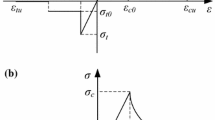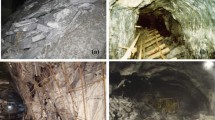Abstract
A methodology to obtain the dynamic force-penetration curve of a rock specimen is presented. For this, a simple portable experimental setup is used. On one end, a hand-held hammer strikes a slender chisel. On the other end the chisel is in contact with the rock specimen into which the generated stress wave propagates. Strain gages installed at a selected section of the chisel are recorded throughout the impact duration. The theoretical signal at the same section is simulated using a numerical method based on the impulsemomentum principle previously developed by the author. Essentially the shape of the simulated theoretical response at the strain gage section depends on the impact velocity of the hammer and the slope of the assumed force-penetration curve. These two parameters are adjusted until the shape of the theoretical signal at the strain gage closely matches the experimental signal. Due to its simplicity, the proposed methodology has the potential of becoming a standard dynamic test for obtaining the force-penetration curvs in rocks.
Similar content being viewed by others
References
Lundberg, B., “Microcomputer Simulation of Stress Waves Energy Transfer to Rock in Percussive Drilling,” International Journal of Rock Mechanics and Minerals, Science,19, 229–239 (1982).
Lundberg, B., “Computer Modelling and Simulation of Percussive Drilling of Rock,” in J. Hudson, ed., Comprehensive Rock Engineering, Vol. 4, 137–154 (1993).
Lundberg, B. and Karlsson, L., “Influence of Geometrical Design on the Efficiency of a Simple Down-The-Hole Percussive Drill,” International Journal of Rock Mechanics and Minerals Science,23, 281–287 (1986).
Chiang, L. and Elías, D., “Modeling Impact in DTH Rock Drilling,” International Journal of Rock Mechanics and Minerals Science,37, 599–613 (2000).
Pang, S.S., “Investigations of Pneumatic Percussive Processes Involving Rocks,” Ph.D. Thesis, Department of Mechanical Engineering, University of California at Berkeley (1988).
Pang, S.S., Goldsmith, W., and Hood, M., “A Force-Indentation Model for Brittle Rocks,” Rock Mechanics and Rock Engineering,22, 127–148 (1989).
Hustrulid, W., “Theoretical and Experimental Study of Percussive Drilling of Rock,” Ph.D. Thesis, University, of Minnesota (1968).
Hustrulid, W.A. and Fairhurst, C., “A Theoretical and Experimental Study of the Percussive Drilling of Rock. Part II: Force-Penetration and Specific Energy Determinations,” International Journal of Rock Mechanics and Minerals Science,8, 335–356 (1971).
Bernaola, J. and Ramirez, P., “Penetration Rate Prediction in Percussive Drilling,” in Proceedings of the 6th International Congress on Rock Mechanics, ISRM, Montreal, Canada, Vol. 1, 595–598 (1987).
Xiaohe, X., Chunan, T., and Dingxiang, Z., “A Numerical Simulation Method of the Impact Penetration System,” in Proceedings of the 6th International Congress on Rock Mechanics, ISRM, Montreal, Canada, Vol. 1, 743–745 (1987).
Karlsson, L.G., Lundberg, B., and Sundin, K.G., “Experimental Study of a Percussive Process for Rock Fragmentation,” International Journal of Rock Mechanics and Minerals Science,26, 45–50 (1989).
Carlsson, J., Sundin, K.G., and Lundberg, B., “A Method for Determination of In-Hole Dynamic Force-Penetration Data from Two-Point Strain Measurement on a Percussive Drill Rod,” International Journal of Rock Mechanics and Minerals Science,27, 553–558 (1990).
Martin, M.T. and Doyle, J.F., “Impact Force Identification from Wave Propagation Responses,” International Journal of Impact Engineering,18, (1), 65–77 (1996).
Wang, J.K., “Bit Penetration into Rock. A Finite Element Study,” Ph.D. Thesis, University of Missouri (1975).
Wang, J.K. and Lehnhoff, T.F., “Bit Penetration into Rock. A Finite Element Study,” International Journal of Rock Mechanics and Minerals Science,13, 11–16 (1976).
Elías, D., “Modeling and Simulation of Impact in Rock Percussive Drilling,” (in spanish), Ph.D. Thesis, Department of Mechanical Engineering, P. Universidad Católica de Chile, Chile (2002).
Kaiser, M.A., “Advancements in the Split Hopkinson Bar Test,” M.Sc. Thesis, Department of Mechanical Engineering, Virginia Polytechnic, Institute and State University (1998).
Timoshenko, S., Young, D.H., and Weaver, W., Vibration Problems in Engineering, 4th edition, Wiley, New York (1975).
Izquierdo, L., “Monitoring, Analysis and Characterization of Rotopercusive Rock Drilling Systems,” (in spanish), Master of Engineering Science Thesis, Department of Mechanical Engineering P. Universidad Católica de Chile, Chile (2001).
Author information
Authors and Affiliations
Rights and permissions
About this article
Cite this article
Chiang, L.E. Dynamic force-penetration curves in rock by matching theoretical to experimental wave propagation response. Experimental Mechanics 44, 167–175 (2004). https://doi.org/10.1007/BF02428176
Received:
Accepted:
Issue Date:
DOI: https://doi.org/10.1007/BF02428176




